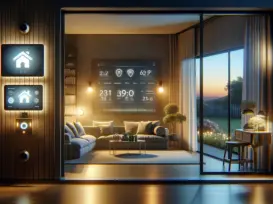Grus Home Energy - Home safety innovations
Revolutionizing Residential Security: Cutting-Edge Innovations in Home Safety
Revolutionizing Residential Security: Cutting-Edge Innovations in Home Safety
In recent years, the home safety industry has undergone a remarkable transformation fueled by technological advancements. From state-of-the-art alarm systems to smart home integrations, the latest innovations in home safety are providing homeowners with unprecedented levels of security and peace of mind. These advancements not only deter potential intruders but also enhance the overall safety of the living environment.
One of the most significant breakthroughs in home safety is the development of smart home security systems. These systems can be controlled and monitored remotely via smartphone applications, allowing homeowners to keep an eye on their property from anywhere in the world. Features like motion detectors, door and window sensors, and automatic locks are now standard components of these systems. Furthermore, they can be integrated with cameras that offer real-time video surveillance, facial recognition, and the ability to alert the authorities automatically in the event of a breach.
Another innovation that has gained traction is the use of artificial intelligence (AI) in home safety. AI technology can analyze behavior patterns and identify anomalies that may indicate potential threats. For example, an AI-powered system can distinguish between a family member entering the home and a stranger lurking around the property. Additionally, AI can be used to predict and prevent hazards, such as detecting the likelihood of a fire breaking out by monitoring temperature fluctuations and alerting the homeowner to take preventive measures.
Voice-controlled assistants have also made their way into the home safety arena, allowing users to activate or deactivate their security systems through simple voice commands. This hands-free operation is particularly useful in emergency situations where speed is critical, or for individuals with mobility issues.
The next frontier in home safety is the integration of Internet of Things (IoT) devices. These devices can communicate with one another to create a fully interconnected home safety network. For instance, smart smoke detectors can trigger the home’s security system to unlock doors and windows for easier evacuation and alert the fire department automatically.
Personal safety wearables are another innovative solution that has emerged. These devices can be worn as bracelets or pendants and are equipped with emergency buttons that, when pressed, send an alert to family members or a monitoring service along with the wearer’s location. This is particularly useful for seniors or individuals with health conditions that may require immediate assistance.
Energy management is also a critical aspect of home security. Smart thermostats and lighting can mimic human activity to make it seem like someone is home, even when the property is vacant. This can be an effective deterrent against burglaries. These devices can also detect unusual patterns such as lights being on when they shouldn’t be, potentially indicating an intruder’s presence.
Lastly, the advent of biometric security measures has introduced a new level of protection to homes. Biometric locks that require fingerprints, facial recognition, or retina scans to grant access are becoming more prevalent. These locks are nearly impossible to bypass, making them an excellent option for those seeking the ultimate in home security.
In conclusion, the landscape of home safety is evolving at a rapid pace, with technological innovations offering smarter, more efficient, and user-friendly ways to protect homes and families. As these technologies become more accessible and affordable, it is likely that they will become standard features in homes around the world, making our living spaces safer and more secure than ever before.
©2025 All Rights Reserved. Grus IoT Co.,Ltd.
